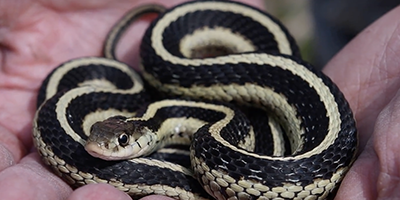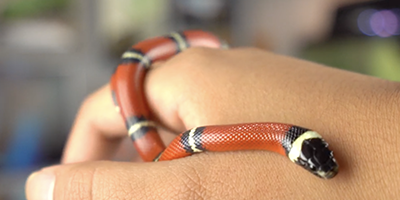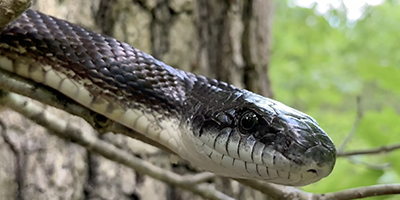
Brown Snake
Latin name:Storeria dekayi
Size: 5 to 15 inches
Venomous: No
The brown snake inhabits a wide range of different environments across the state of Pennsylvania, from swamps, bogs and marshes to forests, woods, and residential backyards or parks. It spends a lot of time burrowing — under soft, moist soils; underneath vegetative debris and loose leaf litter; and beneath piles of rocks, logs, or other items. It rarely finds the need to come above ground, it's main food source - the earthworm - found in the soil. It also eats other insects (often accidentally) as well as slugs and snails, and can help to keep pest insect populations down on farmlands and in gardens.
 Northern Copperhead
Northern Copperhead
Latin name: Agkistrodon contortrix mokasen
Size: 25 to 40 inches
Venomous: Yes
Also known as the southern and eastern (to experts) copperhead, the northern copperhead is a pit viper found in quite a few places across the US — and it is a venomous snake. Fortunately for humans, it rarely bites, is slow to provoke, displays a number of warning signs before it does eventually strike (if at all), would much rather slither away than stay and fight a large predator it can't beat (humans), and has the lowest-strength venom of all pit vipers.
Still, bites do occur, but the first bite is likely to be what experts called a “dry" bite, which means that no venom is pumped into the victim.
Eastern Smooth Earth Snake
Latin name: Virginia valeriae valeriae
Size: 7 to 13 inches
Venomous: No
It is in southeastern Pennsylvania that you may find the eastern smooth earth snake, a name given to the snake because of its smooth, not-ridged scales. It is usually in woodlands, specifically forests, that you’ll come across this species, although sightings over recent years have dramatically declined. It is now classed as a species of special concern in the state and conservation efforts are needed to boost populations.
Being a mostly underground-dweller has made keeping tabs on population numbers quite difficult. As well as being small, and secretive, this snake very rarely comes to the surface.
Mountain Earth Snake
Latin name: Virginia valeriae pulchra
Size: 7 to 10 inches
Venomous: No
This small and slender snake is almost entirely brown to look at, although shades can vary from region to region. It is usually quite dull-looking, either drab-brown, gray-brown, or slightly rust-red brown, and it can occasionally have some markings or spots although these are faint and usually grow out as the snake reaches adult age.
It has very few defense moves to pull out when faced with a predator, such as humans, although it does have tiny teeth and can deliver a mildly-painful nip when handled. It usually releases excrement and tries to slip away as fast as it can, however, hiding in crevices, under rocks or logs, and in grasses or shrubs.
 Eastern Garter Snake
Eastern Garter Snake
Latin name: Thamnophis sirtalis sirtalis
Size: 20 to 28 inches
Venomous: No
You will find the eastern garter snake in so many places across the state of Pennsylvania that it would probably be quicker to list where you wouldn't find it. It never strays far from a body of water, but aside from that it is capable of living anywhere from backyards close to ponds, forests and edges with surrounding lakes or rivers, and even in wet meadows or grasslands.
The main color of the snake is usually brown or a dark green-brown shade, and it has stripes of a light yellow or cream shade, often with spots that sit in between them. The belly is also spotted — dark brown or black spots over lighter creamy-yellow or white scales.
Short-Headed Garter Snake
Latin name: Thamnophis brachystoma
Size: 10 to 22 inches
Venomous: No
It is in the north-west regions of Pennsylvania that you might spot the short-headed garter snake, a green or green-brown snake that is small, slender, and has one stripe that runs down the centre of body, plus one on each side, usually yellow or yellow-white in color.
This snake can live in woodlands and other heavy-tree areas, but it is more common for it to inhabit open meadows and fields, where it stays relatively hidden beneath rocks, logs, branches, and other debris. Experts believe that it’ll only stray out into the open when the weather is cloudy.
Northern Rough Green Snake
Latin name: Opheodrys aestivus aestivus
Size: 22 to 32 inches
Venomous: No
You would need to look up to see the northern rough green snake in Pennsylvania, because it spends almost all of its time up in the trees, or in bushes and shrubs. The green colour of this snake helps it to blend in perfectly, and the rough, keeled scales make it an excellent climber.
It inhabits areas that are close to streams, lakes, rivers and wet meadows, but can also be found in moist grasslands and other wetlands, but, sadly, populations are on the decline in this state. It is now classed as endangered.
Smooth Green Snake
Latin name: Opheodrys vernalis
Size:10 to 20 inches
Venomous: No
If you spot a smooth green snake in your back garden, it's actually advisable to just leave it where it is. This bright green snake species enjoys feasting on insects that could otherwise cause growing plants problems, such as snails, slugs, ants, and caterpillars, as well as spiders, worms, mothers, and butterflies. It is a non-aggressive and non-venomous snake that is just as fast as it is shy. If it spots you coming, it would much prefer to slither away than stay and try to fight you.
Eastern Hog-Nosed Snake
Latin name: Heterodon platirhinos
Size: 15 to 42 inches
Venomous: No
Just as the name would suggest, the eastern hog-nosed snake has a nose just like a hog: upturned at the end, perfect for burrowing and digging around under the ground, and under soft and sandy soils – this species’ ideal habitat.
Despite appearing quite intimidating, with a stout and heavy body, this snake is relatively harmless. The rear-facing fangs make the very mild venom almost impossible to inject into humans, and it’s designed for toads and other amphibians — the snake’s primary food source. The hog-nosed snake is a docile species, too. It has a number of defense mechanisms that it would rather use if fleeing isn't an option.
Kirtland's Snake
Latin name: Clonophis kirtlandii
Size: 12 to 18 inches
Venomous: No
The Kirtland’s snake is a water snake also known by a few other names, including Cora Kennicott's snake, Ohio Valley water snake, and little red snake, and can be found in western parts of the state of Pennsylvania. The red-themed name is given because of the red-tinged underbelly, which often has spots or blotches of a darker colour
With a dark gray-black-brown body, matched with darker spots or blotches, it’s a quite small and slender snake, and it's completely harmless to humans. Not only is this species non-venomous, but there are no bites on record from it.
 Eastern Massasauga
Eastern Massasauga
Latin name: Sistrurus catenatus
Size: 24 to 30 inches
Venomous: Yes
It is in the west of Pennsylvania that you may come across the eastern massasauga – a venomous snake that rarely bites because it is, quite frankly, lazy. As well as being sedentary and preferring not to move a lot, this rattlesnake species likes to dwell in wet, lowland spaces, occasionally moving to higher and drier ground towards the end of spring and in the midst of summer. They can sometimes be seen basking, and it is also common to see them in water, where they are then confused with a number of other species, including non-venomous ones.
 Eastern Milk Snake
Eastern Milk Snake
Latin name: Lampropeltis triangulum
Size: 24 to 52 inches
Venomous: No
The eastern milk snake is a rather common species across North America, and you might even find one right in your very own backyard in the state of Pennsylvania. A burrowing snake that spends a lot of its time underground, the eastern milk snake is sometimes called the leopard-spotted snake, which gives you an idea of what to look for in terms of pattern and color. Although various colours and patterns have been reported, it usually has a leopard-print-style spotted design of red-brown spots over light tan or gray.
Queen Snake
Latin name: Regina septemvittata
Size: 13 to 30 inches
Venomous: No
If there is a running source of freshwater, such as a river or stream, with a rocky bottom and plenty of crayfish, you'll have found the perfect habitat for the queen snake — a semi-aquatic species that is commonly found across southern and eastern regions of North America.
Females are larger than the males, but both have a brown-black and matte-looking appearance, occasionally with stripes of faded, darker scales running along the sides. The underbelly, as with most snakes, is creamy-yellow and can also have darker, faded stripes.
Northern Black Racer
Latin name: Coluber constrictor constrictor
Size: 36 to 60 inches
Venomous: No
As the latin name would suggest, the northern black racer is a non-venomous, constricting species that is found abundantly throughout the state of Pennsylvania. As well as being a fast mover, this snake is skilled at climbing trees to escape human threats and other predators, and you will more often find it in woodlands and forests, or around the edges of them.
The underside of this snake is normally a light-to-medium shade of grey, with a much lighter, almost white colour under the chin. The rest of the snake is almost completely black, although it can be more brown in some regions.
 Eastern Rat Snake
Eastern Rat Snake
Latin name: Pantherophis alleghaniensis
Size: 36 to 72 inches
Venomous: No
If you startle an eastern rat snake on your property, there's a good chance that the snake will simply freeze in place, too scared to move, hoping that you haven't seen it and will just go about your day. As long as you don't provoke or threaten it, it won't be aggressive towards you. It much prefers to eat rats and mice alongside frogs, small fish, and small birds. It will also eat chickens if they aren't safely stashed away in a coop, especially during the spring and fall, when they are active both during the day and night.
Timber Rattlesnake
Latin name: Crotalus horridus
Size: 36 to 60 inches
Venomous: Yes
This species of snake is commonly associated with habitats such as the edges of forests or woodlands, and especially deciduous woodlands, but can also be found along and around rivers, streams, swamps, lakes, and ponds. The main food on the diet is rodents and small mammals, but it will also consume other snakes, including garter snakes and other rattlesnakes, birds and their eggs, frogs and lizards.
This venomous species grows to quite some length and has the potential to do some pretty serious damage to humans, with a high venom yield, but the snake is quite a secretive and shy one, and would much rather be left alone than have to defend itself.
Northern Red-Bellied Snake
Latin name: Storeria occipitomaculata occipitomaculata
Size: 8 to 16 inches
Venomous: No
The northern red-bellied snake, also known as the fire snake, has, just as the name implies, a bright red underbelly that is visually quite striking against the darker top of the body. A snake that is mostly active at night, it barely grows to more than 15 or 16 inches, and with brown, gray, or black colourations and a wide variation in patterns, it would be easy to miss it in the undergrowth in moist forests and woodlands. The species does stray into residential and commercial areas, particularly in those with gardens or parks. They find their prey - worms, slugs and snails - in the soft soil.
Eastern Ribbon Snake
Latin name: Thamnophis saurita
Size: 20 to 34 inches
Venomous: No
The ribbon snake is quite a common snake in some places in south-east USA, but the eastern ribbon snake is an endangered species in the state of Pennsylvania. It is quite adaptable and can live in a wide range of moist/wet habitats packed with lots of vegetation, such as lakes, ponds, streams, and marshes, but it is still thought to be on the dramatic decline in this part of the country.
Northern Ring-Necked Snake
Latin name: Diadophis punctatus edwardsii
Size: 10 to 15 inches
Venomous: No (Yes, but it doesn't affect humans)
The ring-necked snake, as the name would lead to believe, has a ring of color around its neck that stands out from the dark, often black rest of the body. In the northern subspecies, the band of color around the neck is unbroken. This distinguishes it from the southern subspecies; the neck ring is broken. The body can also be dark brown, slate gray, or even blue-black in color. They have been observed in a vast array of habitats, including in caves, hardwood forests, lowlands, floodplains, and in dry forests.
Northern Water Snake
Latin name: Nerodia sipedon
Size: 20 to 55 inches
Venomous: No
This semi-aquatic snake inhabits slow-moving or still bodies of water, or the land just around it, preferably with larger, open spaces. It is not uncommon to see the northern water snake basking in the sun, in shallow waters, and juveniles like to stray a little further from the body of water to find food and basking spots. The snake is a mostly solitary one, but groups of the northern water snake can come together to bask during the summer.
With dark gray, brown, or tan colourations and band-like blotches of darker color, they darken as they age, often appearing completely black as adults on land.
Copper-Bellied Water Snake
Latin name: Nerodia erythrogaster neglecta
Size: 24 to 40 inches
Venomous: No
The copper-bellied water snake is an endangered species in the state of Pennsylvania, and sightings are now reported to be very rare. It once inhabited river bottoms, swamps, and wet woodlands, but a lot of those spaces have been cleared to make way for residential, commercial, industrial or even agricultural land. For the most part, Williams County is the best place to go for a sighting, but despite being quite active, you probably catch a glimpse of this species in the state.
Eastern Worm Snake
Latin name: Carphophis amoenus
Size: Under 15 inches
Venomous: No
A very shy, secretive, and well-hidden snake, there's a good chance that you wouldn't ever realize you were standing in close proximity to the eastern worm snake. Even if you did, you might wave it off as just another large earthworm in the garden. Rarely getting to longer than 15 inches, and looking very much like an earthworm in terms of thickness and general color/appearance, it earns the worm name. It even eats earthworms (and slugs/snails), meaning that they keep pest insect populations down.